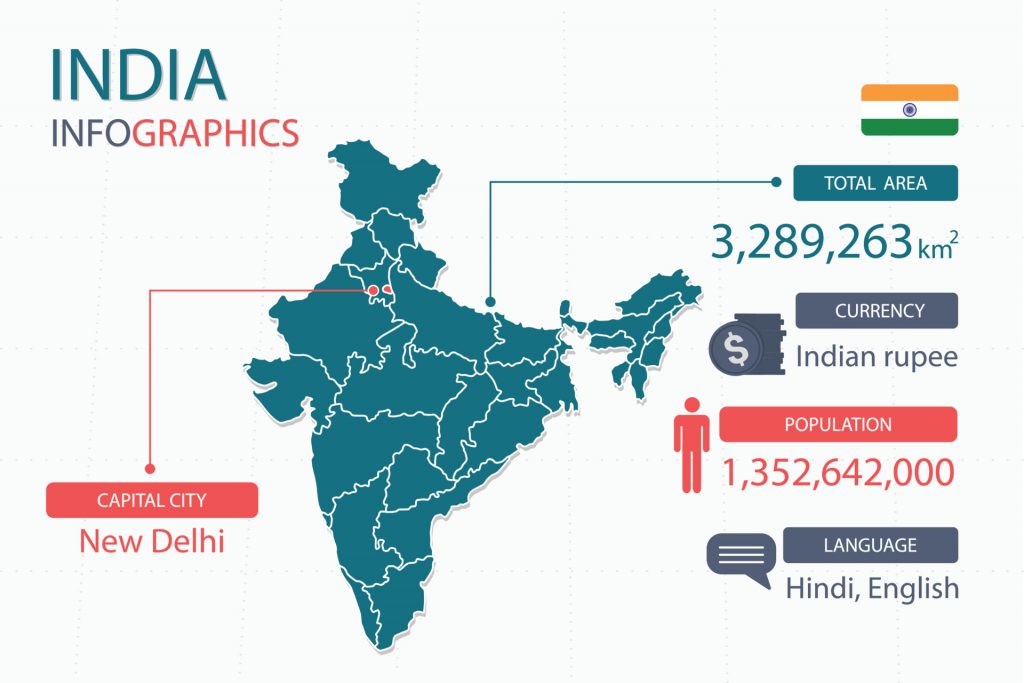The origins of the Marathi Language
Marathi is a language that is spoken in Western India. It is one of India’s 22 scheduled languages, which is a group of languages recognized by the Indian government. In India, it is the one of the co-official languages in the states of Maharshtra and Goa. There are about 73 million people who speak Marathi, mostly of people who are of Marathi ethnicity. In the whole world, it is the 19th most spoken language.
A few characteristics make Marathi unique compared to more well-known languages of the world. Grammatically, Marathi is a language where the verb comes at the end. However, in general, the word order is rather flexible compared to languages found in the west. Marathi also has a gender system containing male, female, and neuter. This is comparable to languages like German. Another interesting grammatical characteristic has to do with how we is expressed. There is an inclusive we, where in a sentence like “We go to the store,” the we includes the person that is also being spoken to, but also an exclusive we, where it refers to the speaker and other people, but does not include the person being spoken to. These two would have different pronouns.
Marathi is also culturally unique compared to other world languages as it has a very long and rich literary tradition that can be identified, dating back to 900 AD. It is considered such an important language in India, that the government has given it its own language day, that officially falls on February 27.

Marathi is part of the Indo-Aryan language family. Many other languages found on the Indian subcontinent belong to this family, including Punjabi, Gujarati, and Standard Hindi and Urdu. As many other languages in this region, its vocabulary has been influenced from a wide range of sources due to a history of a variety of influences from a number of cultures and people. Much of its vocabulary comes from Sanskrit because of Sanskrit’s status of the main liturgical language of Hindi, a major Indian religion. In addition, other Indian languages have also had influence due to close geographic and cultural proximity. Another major influence is Persian, due to Persian rule, and contact with Persian cultural aspects in general, such as trade, migration patterns, etc. Other influences include Arabic, and more recently Portuguese and English.
Marathi may be unique to some because of its history in terms of writing. Up until recently, many writing systems have been utilized. In the past, the Kadamba alphabet was used and this was continued until the middle of the 20th century. Kadamba was also used to write other languages such as Kannada and Sanskrit. The Modi alphabet has also been used as well, and was an official script until around the same type Kadamba came out of use. At the time when Modi was more prevalent, both Modi and another script called Balbodh was used, perhaps due to convenience. However, after printing technology appeared, Balbodh was favored. For this reason, we see many Marathi documents that are written in Modi to be handwritten while Balbodh documents are usually handwritten and printed.
Balbodh is actually the name of a certain style of the Devanagari script. It is slightly modified to fit the proclivities of the Marathi language. It is an abugida; in this type of writing system, the consonants are the main components and vowels ‘attach’ onto them to modify their sound. There are 36 consonants and 16 vowels. The vowels attach onto the consonants to change the consonant sounds. This is a bit different than the majority of western languages where consonants and vowels are separate letters. It is written from left-to-right. Unlike other languages in the region, when Marathi is written, western punctuation is used such as full stops/periods, commas, etc.
Marathi is a language derived from earlier iterations of the Prakrits, a group of languages and dialects from around the 3rd and 4th century BCE. As mentioned before, much evidence of literature exists for the language, with the earliest dating back to 900 AD. In the 12th and 13th century, the language became closely associated with Mahanubhava, a religion widespread in the region that Marathi was spoken. During Indian medieval times, Marathi literature began to earnestly develop. Around this time, the region was under the control of the Sultanate and the Marathi language was highly influenced by the Persian used by the Muslim rulers. As the Sultanate recognized the importance of the language to communicate with large swaths of the population, Marathi was widely used, especially as the language of public administration and governance
The Marathi language had its most prominent time during the Maratha Empire starting around 1674. Historians have noticed that documents at this time were less ‘persianised’, therefore demonstrating the waning influence of Persian cultures. During this time, much literature such as poems and ballads continued to develop and such works are thoroughly documented.
In the 1800s, British colonial influences affected the development of Marathi language. At this time, missionaries made efforts to produce Marathi grammars which in led to a more standardized version of Marathi with the grammars as a basis. During this time, the Bible was also translated into Marathi. The first Marathi-English dictionary appeared in1831 and the first Marathi newspaper appeared in 1832. Musicals, called Sangeet Natak, also appeared prominently featuring the language.
After India gained independence, it has become a scheduled language of India. Since then, it has remained an important language, especially for many of the arts. Marathi film, music, drama and literature are all quite important. After independence in 1958, a genre of literature emerged with the Marathi language called Dalit. Currently, it remains a vital language for Indian arts.
VEQTA can provide you with a perfect Marathi translator for your Marathi translation, English to Marathi translation and Maltese to english translation for the your targeted locale. Our translations to Marathi are created with your target audience in mind to meet your expectations.
If you need to translate Marathi – Get in touch today!
A dedicated team of Marathi translators who combines Experience, Specialized Subject Matter Expertise with best Translation Practices to deliver quality second to none.
Marathi Subject Expertise
Marathi Translators
Marathi Editors
Marathi Copywriters
Marathi Reviewers
Marathi Voice dubbing
Marathi Subtitling
Marathi Transcription


